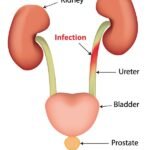General Urology Care

Kidney Stone Treatment

Prostate (BPH) Treatment

Urinary incontinence

Blood In Urine

Testicular infection treatment
Benign prostatic hyperplasia (BPH)
The prostate is a Sexual gland present in men which contributes to Semen production. As men grow, Prostate may get enlarged and compress the urethra (urine passage).
If you have symptoms of pelvic pain or heaviness, pain in your genitals, lower back and buttock pain, pain during urination, difficulty urinating or even frequent urinating, or getting up many times at night, you might have a problem with your prostate. Now you might want to ask what’s a prostate and where is it located in your body.
The prostate is a part of the male reproductive system. It’s just below the bladder (where you get the sensation of passing urine) in front of the rectum (which leads to the opening in the buttocks). Its primary function is to produce fluids that, together with sperm cells from the testicles along with other fluids, make up the semen. The muscles in the prostate also help expel the semen during ejaculation.
BPH is a condition in which the prostate gland gets enlarged, causing the symptoms discussed above.
In the early stage for mild symptoms life, and style changes weight loss and dietary changes can be sufficient to cure this problem. For moderate symptoms medications, to relax the prostate muscles to ease up the symptoms or medicines that shrink the prostate by preventing hormonal changes, are the best options for you.
For cases with severe symptoms or significant enlargement Otherwise, there are minimally invasive surgical therapies to treat BPH. HOLEP is popular latest and most advanced treatment option with fast recovery and minimal blood loss. It is very much necessary for patients with comorbidities and with large prostate as conventional TURP techniques can pose higher risk or slower recovery.
Urinary incontinence
It’s one of the most embarrassing, yet benign, medical issues. We all know how babies soak their beds with urine. They do it accidentally as they don’t have control over their bladder.
Now, What if adults have urinary incontinence and soak themselves in the office or bed? Embarrassing, isn’t it?
The condition can be present in both men and women of all ages.
The problem is due to an overactive bladder. It’s more common in older women. During an occasion of normal urination, the bladder muscles tighten to move the urine into the tube-shaped urethra. The muscles around the urethra relax to pass the urine through the penis.
Urinary incontinence occurs when bladder muscles don’t work as they should. Leaking the urine accidentally.
The condition can be treated by bladder control exercises lifestyle & dietary changes. Ask your doctor to inform you about the exercises that you could do yourself.
Medically, they could be treated with medications. Or other techniques like electric nerve stimulation (neuromodulation). Some cases with severe overactivity may need bladder Botox therapy.
If nothing else works, then the only option is surgery. In men, prostate surgery can reduce overactivity symptoms, while in women Continence procedures are helpful. Extreme cases with small bladder may need surgery to increase bladder size (augmentation).
Blood in the urine (Hematuria)
If you find your urine color to be pink, red or brownish-red, then it’s a sure sign of blood in your urine. Technically, the condition is called hematuria.
Blood in the urine is not always sensed by the person with the condition. But if you have the following conditions, then it could be a case of hematuria.
- If you have a burning sensation while urinating, it’s probably a bladder infection causing internal bleeding.
- Kidney infection usually causes fever, chills and pain in the lower back. And blood in the urine that is rather disguised.
- Kidney stones can also cause this condition.
- If you experience weight loss, loss of appetite, fatigue or pain in your side, then it’s probably kidney cancer that’s causing undetectable hematuria
- Other types of kidney diseases can also cause hematuria.
Other risk factors causing this condition are:
- Enlarged prostate or Urine infections
- Use of medicines like aspirin or penicillin
- Sickle cell anemia and cystic kidney disease
- Cancer in the kidneys, bladder or any part of the urinary tract.
- Vigorous exercise (in athletes or army persons)
Any episode of blood in the urine (even microscopic) should be thoroughly evaluated even if it has stopped, as in cases of cancer it may not present all the time. Especially people of all ages who smoke or consume tobacco, those with family history of cancer, and all above 50 years of age.
Testicular Infection treatment
An Infection can cause the inflammation of a coiled tube called epididymis in the testicles that store and carry sperm. This condition is called epididymitis. It can be caused by bacterial infections, including but not limited to sexually transmitted diseases like gonorrhea or chlamydia.
Symptoms include:
- Discharge from penis
- Painful urination
- Frequent need to urinate
- Blood in semen
- A red, swollen or warm scrotum
- Fever
